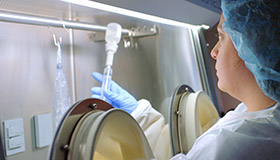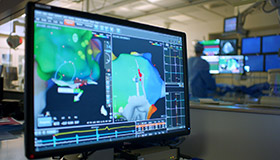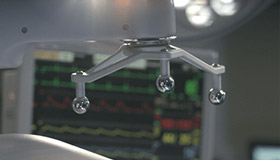Using Radiation to Keep the Heart Pumping
As a husband, father of six, grandfather of 14 and of two great grandchildren — and still working a full-time job — Jim Taylor needed his heart to keep up with his busy lifestyle.
His cardiovascular disease had its share of ups and downs over the years — triple bypass surgery, an aortic valve repair, and more than 20 stents placed in his arteries. And in June 2019, chest pain, shortness of breath, and indigestion led him back to Allegheny General Hospital. He was diagnosed with restenosis of the right coronary artery and needed a fix — fast.
Luckily, David Lasorda, DO, director of Allegheny General Hospital (AGH) Division of Interventional Cardiology was there with a life-changing solution.
An unexpected treatment for the heart
Using a treatment called intra-coronary vascular brachytherapy — brachytherapy is a radiation treatment that is typically used with cancer patents — a drug-coated cardiac stent was placed in Jim’s re-narrowing artery.
“Intracoronary brachytherapy gives us an effective option for patients, like Mr. Taylor, who have experienced repeated restenosis after angioplasty and stent placement,” Dr. Lasorda said.
The treatment delivers a small, precise dose of radiation directly to where the artery has re-narrowed, eliminating or greatly reducing the growth of cells that cause restenosis. Since receiving the treatment, Jim has seen a significant improvement of his indigestion and chest pain.
“I feel a heck of a lot better, and I’m knocking on wood that it keeps up,” Jim said. “The shortness of breath comes and goes, but the important thing is that I should be able to go longer now without restenosis.”
Working together for better outcomes
AHN cardiologists and radiation oncologists work together to perform intra-coronary vascular brachytherapy. Once the block is reopened, a low dose of radiation is precisely delivered to the area through an X-ray-guided heart catheter. Once complete, the catheter is removed so that radiation isn’t left in the body.
“For years, we have been treating cancer patients with brachytherapy, placing radiation directly in or near malignant tumors to help eradicate them,” said Mark Trombetta, MD, system director of Clinical Program Development, Allegheny Health Network Cancer Institute.
“The same process that eliminates cancer cells has proven to be equally effective at inhibiting the growth of cells that lead to scar tissue and plaque that causes blood vessels to narrow.”
Studies have demonstrated a significant reduction in restenosis and heart attack following the use of intra-coronary vascular brachytherapy in patients who, many times, have no other options to help them return to their daily activities. And what’s even better — most patients are able to return home the day following the procedure.
Contact Us
If you think intra-coronary vascular brachytherapy could positively impact your health or the health of a loved one, request an appointment with one of our experts or get more information about Allegheny Health Network Cardiovascular Institute.





